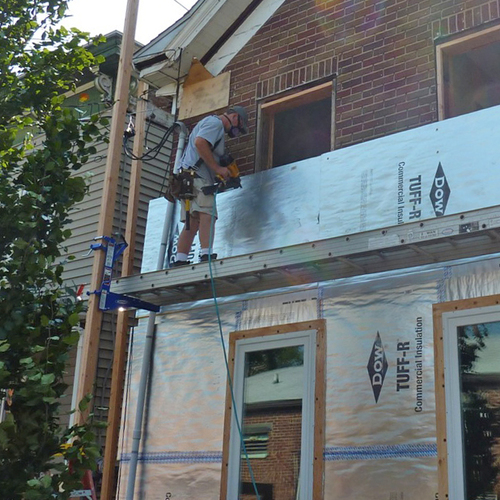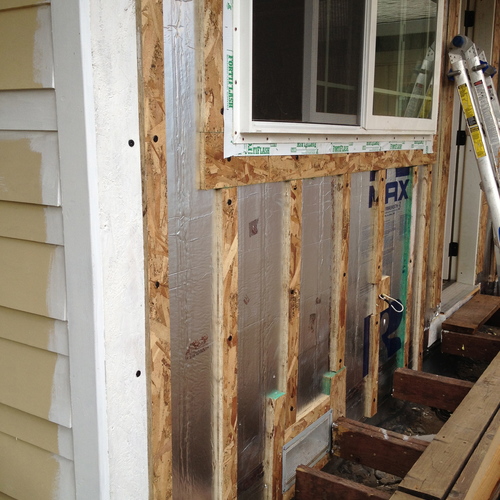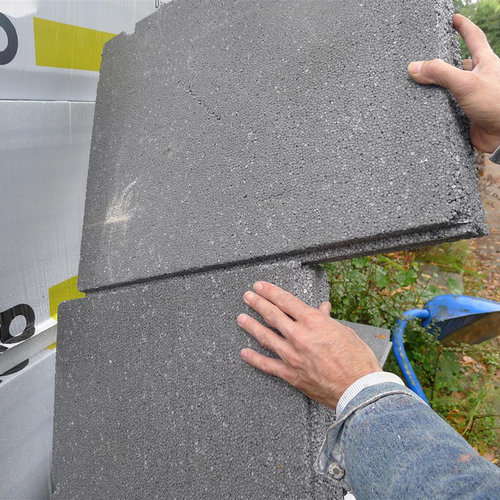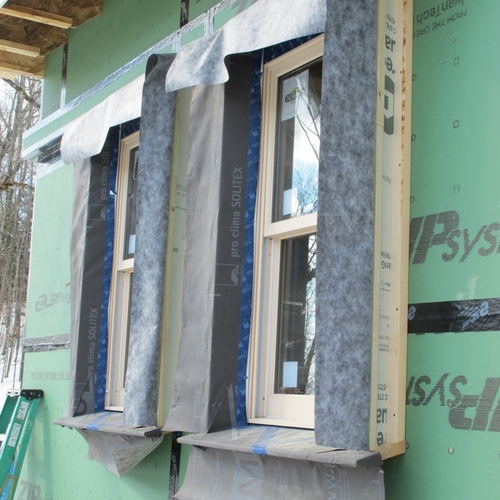
The late 2000s and early 2010s saw a surge of interest in deep-energy retrofits. Around that time, many of us in the green building community started coming to terms with the magnitude of emissions reductions needed to avoid catastrophic climate change. Inspired by the ultra-low-energy new homes of the Passive House movement and a President who assured us that “insulation is sexy stuff,” we sought ways to achieve deep-energy reductions in existing buildings. Our goal was to move beyond the approximately 30% savings on space heating and cooling energy typical of conventional retrofits toward the 50% to 90% we believed was needed to achieve climate protection goals. This kind of performance improvement required us to evaluate all of a building’s surfaces to look for opportunities to reduce heat transfer.
Above-grade walls are usually the most technically challenging—and expensive—component of a deep-energy retrofit. In existing homes, wall insulation is limited by the depth of the existing cavity, and the wall’s performance is further diminished by thermal bridging through studs and other framing members. To go beyond about R-20, it’s necessary to add insulation to either the inside or the outside of the wall. Most deep-energy retrofits involve removing siding and adding one or more layers of foam board to the exterior of the house. Windows and doors may or may not be replaced as part of the project; in either case, close attention needs to be paid to flashing these openings. Once the foam is in place, new siding is installed, usually over furring strips. Window and door trim and sometimes roof overhangs may need to be modified to accommodate the extra wall thickness.
Some early deep-energy retrofits, like those done by Paul Eldrenkamp’s team in Massachusetts, provided inspiration and proof of concept. However, the high cost ($140,000+) and…
Weekly Newsletter
Get building science and energy efficiency advice, plus special offers, in your inbox.

This article is only available to GBA Prime Members
Sign up for a free trial and get instant access to this article as well as GBA’s complete library of premium articles and construction details.
Start Free TrialAlready a member? Log in















19 Comments
This is a really fantastic article, and provided a much needed gut check for my own aspirations of piling r-25 onto the walls of our older ranch.
I'm glad you think so, Brian. Jon's contributions are always thoughtful and information-rich. I appreciate his take on this topic, in particular, because deep-energy retrofits get a lot of play but not many people go into depth like he has--and then decide against them.
Thanks Brian and Kiley! Glad for this opportunity to share some of my personal experiences in this area.
Walls and windows are low on my priority list when upgrading. My own shallow energy retrofit was as follows. Air seal the attic, extend air chutes, add to the R-38 fiberglass to R-100. Rim joists to R-25, basement interior foundation walls from 0 to R-10. replace the 70% gas forced air furnace with a 95%. Energy usage for heating went from 1000 therms to 600 therms annually. Total cost of project was 7k.
Yes, excellent article. I've always suspected that this was generally the case, but it's great to see some actual numbers put to the technique. "Pretty good" just seems better and better.
Fantastic article. The good thing is that you started with a home without water damage behind the siding, and no termite damage, no mold, no structural deficiency. That saves a lot of money. A lot of homes have these non-energy deficiency cans of worms that are found when walls start being opened that make costs spiral out of control.
I agree, instead of deep energy retrofit, modest envelop energy efficiency upgrades coupled with heat pumping everything and some inexpensive solar is a much more cost-effective solution.
My head just hurts from thinking about what to do about the homes that have a lot of cans of worms beyond energy efficiency, problems that often degrade the efficiency of the home such that even if there are R19 batts in the walls, they are certainly not performing at anywhere near R19 for example.
Edward,
Your can of worms situation could make a better case for a deep energy retrofit. If a house has old and defective windows and doors and there are serious defects inside the walls that cannot be properly addressed without removing the siding, then there is an argument that the cost of the deep energy retrofit is far lower than listed in the article, as the most expensive work had to be done anyhow. In this case, the marginal cost of the added insulation is actually relatively low.
This is not an unusual case. Considering that, for most of the last 50 years or so, siding, doors and windows have been built for an expected lifespan of 30 years, there are lots of buildings with doors, windows and siding that have exceeded their expected useful lives. Rather than installing yet another layer of siding over the old stuff, and rather than installing "replacement" windows piecemeal, it makes economic sense to do the whole project at once, which produces better results. Unfortunately, this work is often done by house "flippers," who care little about energy efficiency, durability or performance. There are opportunities out there for people with imagination (and fat wallets), but few home buyers fit that category.
Yes. One way to approach it is to roughly estimate the cost to repair the problems, without an energy upgrade, and then see what the cost adder is to include the upgrades. The buzzword should maybe be "no regrets remodeling" (coined by Home Energy Magazine for a book title several decades ago) rather than "deep energy retrofits".
In the example of my house, we needed new siding, and included insulating under it; we didn't plan on new windows but went ahead with it when we found that many of the old ones were rotting from half-hearted flashing work when they were installed in 1970. We had basement water issues, and insulated the basement walls while we were excavating for drainage. Lots of other things in the house turned out to need work, and the cost escalated, but those were the costs of making a low-quality 1970 house into something that will be more durable, better looking, and have fewer ongoing maintenance issues. The energy-only work was primarily air-sealing and insulating the attic and that was one of the lowest cost pieces of the project.
I like that--"No Regrets Remodeling." I don't think I've heard it before.
Very good article. Did you run calculations on the marginal costs for the deep energy retrofit? What kind of ROI did you net?
Thanks Robert. I looked in detail at the West Hill house and did an energy model on a standard, comprehensive retrofit (all measures except exterior foam & siding) versus the actual deep energy retrofit. I included the conduction improvements from the added R-value and gave the exterior wall treatment credit for 700 CFM50 of blower door reduction, which is probably generous. The DER treatment essentially doubled the cost of the retrofit but only added about 15% in gas savings. The payback on the marginal improvement was very long, on the order of 200 years.
So if I'm reading this right, your comprehensive retrofit for West Hill would have achieved about 50% in gas savings by itself? So the marginal cost from a significant improvement to an even more significant improvement is poor. Seems like a strong demonstration of decaying returns, yes?
How would the marginal costs of going from a like-for-like replacement (i.e. say the siding is due for renewal anyway) straight to a DER? Strip out the labour and material for the siding and just look at the incremental costs of the added foam, air tightness, incremental improvement on better windows, etc.?
Good summary, but it's a shame to see articles like this that focus only on the cost benefit and not on the air quality aspects. Nobody should be discussing retrofits of any type without addressing how building science has been / needs to be employed to make sure air quality (especially mold) doesn't get worse. After all, partial energy retrofits are responsible for a huge amount of moldy homes. Everything needs to be looked at as a system and saving $ only to end up with a house full of sick people does nobody any good. I believe this concept still isn't top of mind for a lot of people or it would have been mentioned.
I agree with you insofar as, like you say, we shouldn't be doing 'partial energy retrofits' that would result in mold growth and deteriorating IAQ. But I don't think that was what the author was suggesting at all.
My takeaway from it was that going much beyond what is needed to keep your walls air tight and condensation-free becomes a situation of rapidly diminishing returns if viewed from a ROI perspective, and the money that would be spent on additional insulation beyond that which creates a safe, healthy assembly would be better spent on electrification by way of HPWHs and heat pump HVAC systems.
While it isn't explicitly mentioned by the author—and perhaps could be for those new to the concept of building science—I'd wager a guess that when the author states "Sealing air leaks reduces drafts and prevents unwanted moisture migration. Raising surface temperatures through insulation also improves comfort and prevents condensation.", the underlying concern is the health and safety of the occupant.
Sure, we can read between the lines, and those who have studied building science know air sealing is very helpful and that you have to be careful what you're doing to not trap moisture or cause condensation. But not everyone is well versed in this and since nothing is more important than air quality, I feel it is only responsible to always address it.
That presupposes there really are houses "full of sick people" due to partial energy retrofits. It's a claim that needs some evidence.
Wondering if you would be able to provide a rough estimate of % cost for labor that went into the projects?
Where my mind is going with this is... since the DOE weatherization program seems to be lacking funds... what if there was a organization/non-profit like Habitat for Humanity where volunteers/contractors donated their labor specifically for DERs in an effort to help reduce operational carbon. Would it make more sense and be able to scale then?
This really is a great article, with so much wisdom about the path forward for existing homes. It's hard when something you've put a lot into doesn't work out, but that's how we learn. When you write it down so others can learn from you, you become a pioneer. Thanks.
DIY 'shallow energy retrofit' still on the cards for me. As well as continuing the energy electrification.
ROI is not always just about $$, comfort and health do have a value to people but yes, I doubt for many it's in the $50,000+ range.
And no disrespect to your current business, as I am a huge proponent of electrification and heat pumps in particular, but an $18,000-$30,000 investment for heat pumps with an ROI of 20 years is also going to be a huge pill for many to swallow. I'd wager it pretty much targets the same populations of folks that the deep energy retrofits do. I mean, how does the heat pump retrofit compare to $18,000-$30,000 spent on a home solar system for ROI? Gotta much better than 20 years, even in sitautions where it may not be ideal?
Log in or become a member to post a comment.
Sign up Log in